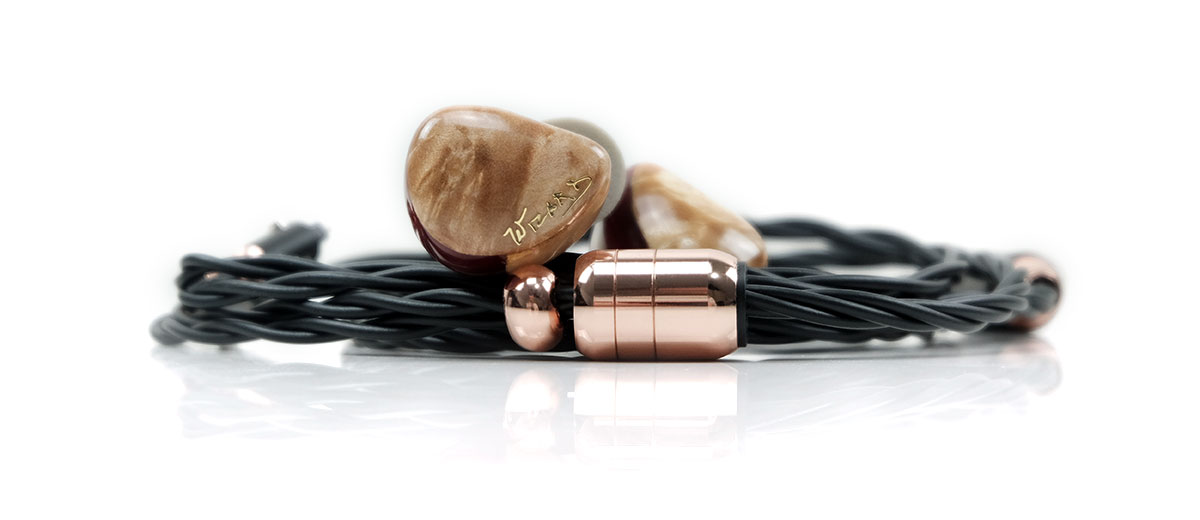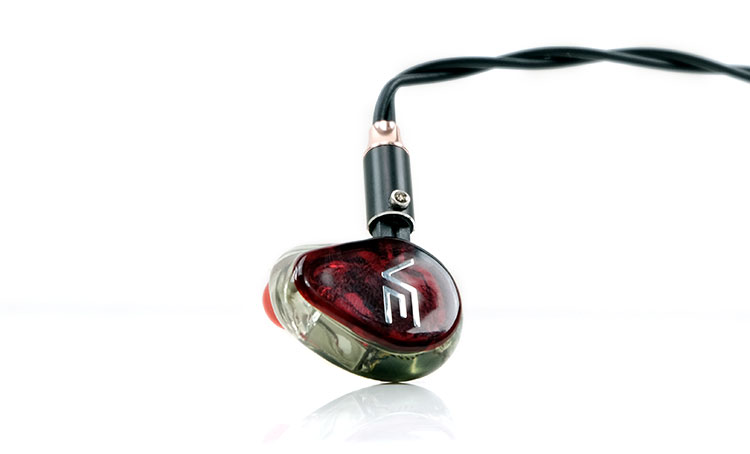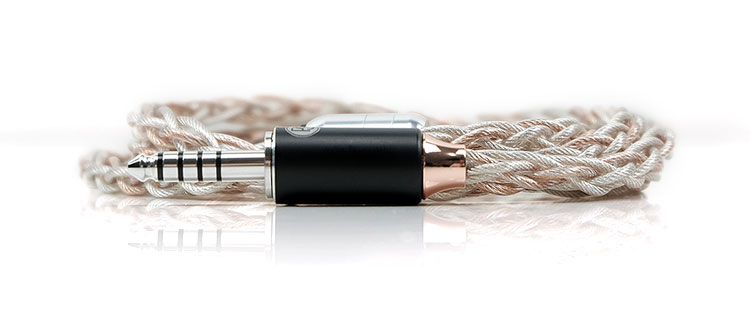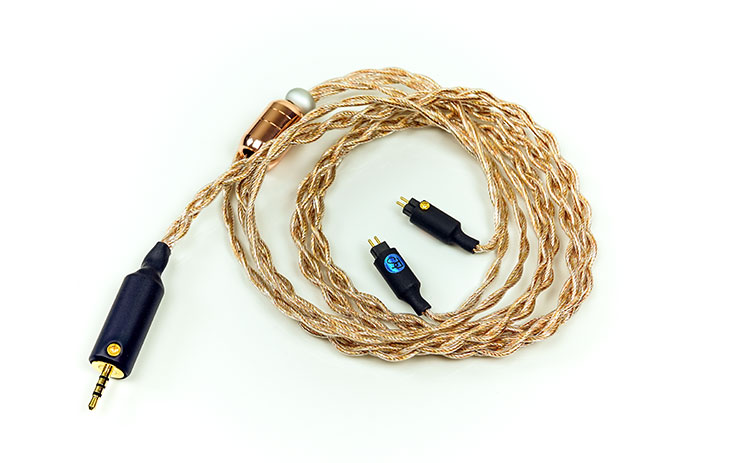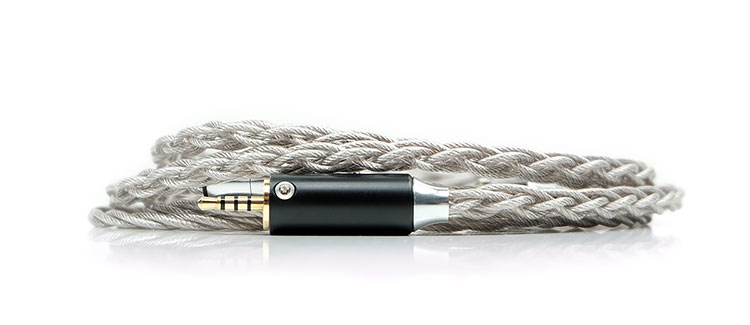Performance Impressions
Summary
Our tested pairings left us with no doubt that this was a pure copper cable sound signature. Compared to the alternative PS cables such as the Palladium-Plated hybrid and the fairly reference sounding Tri-Hybrid, the Copper+ delivered a smooth, rich, and relatively euphonic sound signature.
However, unlike the earlier Tri-Copper EXO, which is our nearest 4-wire alternative, Copper+’s larger 24AWG wiring stretches its legs a bit more and that means better high-frequency reproduction and more treble information, a blacker background, and superior instrumental separation.
Tri-Copper still gives you the thickest and weightiest low-end and possibly the broadest and more intimate vocal note but it sounds quite rounded and lacking in the same level of resolution compared to Copper+.
The new Copper+ simply sounds more expansive and complex, teasing out an improved level of detail in low-end texture whilst still pushing forward the bass presence to a satisfying level. The warmth is there but it is not overpowering, in fact, the transparency from the Copper+ with monitors I had not expected to pair well with is surprisingly good.
Timbre
In most instances with our tested monitors, the Copper+ did tease out a fairly strong low-end response, enhanced sub-bass rumble, and decent warmth across the bass to lower-mids. Monitors such as the all-BA U18s from 64 Audio sounded planted with a firm and ever-present physical sounding bass timbre.
Personally, I found the PPH to provide a little more dynamic impact and definition from the sub-bass response on our dynamic driver monitors such as the UM MEST MKII but it wasn’t an omnipresent characteristic quite like the Copper+ performance.
You only heard the excellent PPH sub-bass response when tracks hit that low end hard, otherwise, it did not quite have the same ever-present richness or body sounding a little lighter through the midrange and vocals.
Despite that, I actually found the Copper+ timbre to have a somewhat relaxed overtone, a bit more to the even harmonic but not so much that chest and mixed vocal sounded rounded and dull.
This was more like a slightly liquid attack and a longer decay through the midrange which did very well with the likes of the perky Khan and mid-forward Odin vocals, damping down on sibilance or distracting dissonance such a dry splashy percussion.
Treble on our tested monitors sounded very natural but not pushed or overtly forward sounding. Not as truncated as the Tri-Copper and definitely airier and cleaner sounding but not quite the strident and drier timbre of the Tri-Silver.
Staging
I thought the Copper+ did very well with instrumental separation, much more so than the Tri-Copper, and brought along with it a certain amount of mid-bass and lower-mids physicality that is less present in the likes of the Tri-Hybrid.
Certainly, the Copper+ does very well on the low-end, providing some excellent depth, particularly with dynamic driver hybrids. The overall attack of the low-end is perhaps a little softer than the PPH but the weight and textural richness come out very nicely with the likes of the tia Trio and the Odin.
You could argue that the Copper+ staging is not hugely aggressive, more of a relaxed and very balanced feel to its delivery with a midrange performance that is not as close or intimate as the Tri-Copper but benefitting from improved stereo imaging. There is also simply a lot more sparkle in the highs compared to the Tri-Copper giving the stage a more holographic quality.
Synergy
Flexible
The Copper+ is much more of a flexible cable for pairing with various monitors than I initially thought it might be. It doesn’t have that same treble dampening effect as the Tri-Copper and retains a fair amount of space and excellent levels of resolution with our tested IEMs.
For example, before testing with the 64 Audio u18s, I was fairly sure that the reference quantity and slightly laid-back sound signature wouldn’t be an ideal match for the already smooth and rich performance of the Copper+. Far from it, the vocals sounded a lot more solid with the U18s plus than either the PPH or the Tri-Hybrid from PLUSSOUND.
Granted, both of those cables do slightly better if you want a bit more treble presence but the gap is not huge. Both the Copper+ and PPH were also excellent in pushing forward the u18s low-end.
The PPH is more studious on when to bring forward the bass definition, but the sub-bass definition is better when it comes. However, for a generally thicker and weightier low-end, the Copper+ and u18s pairing was excellent.
Upgrades on Stock
There are some high-end monitors, however, that cannot fail to get a lift from the Copper+ pairing. IEMs such as Vision Ear’s EVE20 are normally paired with a very basic 4-wire OFC cable which kills the dynamic range and power. It’s a safe choice but not an impressive one.
Copper+ really adds some welcome power and solidity to the EVE20’s low-end, some welcome richness to the midrange, and improves that dynamic range widening and keeping the staging quality immensely.
Controlling the Highs
Monitors with a heady upper mids or sharper treble also pair very well with the Copper+. IEMs such as the Noble Khan and its dry spikier treble output sound a lot smoother with this cable pairing though to be fair the signature difference is not night and day.
The same could be said with the Odin to a less extent with its forward upper mids. Copper+ didn’t strip the body out and keep the treble overtone quite smooth so vocal timbre never felt sharp or harsh sounding. Both it and the Khan’s dynamic drivers also sounded fantastic with the Copper+ with a nice solid sub-bass performance and decent warmth.
Select Comparisons
PLUSSOUND Tri-Hybrid
$899
Technical
An extremely different design approach and a very different geometry to the Copper+. The Tri-Hybrid uses the company’s traditional Type 6 Litz approach to cable building as opposed to the new coaxial type design inside the Copper+.
This particular sample is 6 wire but both come in a 4-wire version. However, the Tri-Hybrid is offered in a smaller 26AWG wire gauge than the 24AWG of Copper+. As far as I am aware the shielding on the Copper+ runs the complete length of the cable which is not the case on the Tri-Hybrid.
In terms of materials, the Copper+ is what it says it is a single element of UP-OCC copper wire split into two Litz-type bundles. Whereas the Tri-Hybrid is consists of another 3 elements per 2 wires (6 in total). This includes 2 wires of Tri-Silver, 2 wires of Tri-copper, and 2 wires of T-Metal, all their hybrid blended wires in one go.
Design
The aesthetic and handling are very different but there is some commonality around the finishing between the Tri-Hybrid and Copper+.
The translucent jacket of the Tri-Hybrid means a bright sparkling mix of gold, silver, and copper shining through, whereas the Copper+ finishing is totally black save for the barrel accents. In truth, there will be fans of them both and I can’t deny preference here since both have a very appealing aesthetic.
In terms of overall dimensions, the Copper+ is the thinner of the two cables despite having a larger gauge size. Granted, the Tri-Hybrid I have here is 4-wire but even the resident 4-wire Tri-Copper is a thicker cable.
However, the handling is where the Tri-Hybrid has a slight edge with its braided softer structure allowing for less microphonics below the splitter. Both offer good handling discipline but the Copper+’s twisted finish is more composed when in use and the Tri-Hybid is more pliable and not as stiff in the hand.
Both have the same jack, barrel, cinch, and connector options when purchasing but from a preference point of view the rose gold on black stands out a bit more on the Copper+.
Performance
The Tri-Hybrid is the more neutral of the two cables with a cleaner tone, a bit more treble presence, and a midrange imaging that, at times, can sound a little further forward depending on the monitor pairing.
The Copper+ is the richer and warmer sounding of the two, with more low-end weight, more body through the midrange, and a smoother sounding instrumental and vocal timbre. However, it doesn’t push the treble as far forward and tends to tease out a bit of a longer instrumental decay from the paired monitors.
That gives the impression that the Tri-Hybrid is the more articulate of the two in terms of energy and pace with its drier shorter decay. In reality, the more subdued low-end and stronger treble influence simply allows the mids to come more into focus with more sparkle in its harmonic balance.
If you need the power and a bit more depth, more body on the mids, and a more forgiving euphonic tonal quality to your monitor’s mids and vocals, the Copper+ is the wiser choice here. If you need more sparkle, a cleaner midrange tone, and a neutral low-end, then the Tri-Hybrid is more favorable.
In terms of dynamic range, there is not a huge difference here despite the different wire and gauge specifications. You might find higher-frequency spatial cues a bit easier to pick up on the staging qualities of the Tri-Hybrid and a mid-range positioning that is a little further forward than the Copper+.
PLUSSOUND Tri-Copper
$549
Technical
The Tri-Copper sample we have here is also from the PLUSSOUND EXO series so like the Copper+ this is also a 4-wire creation. However, that’s about it in terms of shared features aside from the house barrels, connectors, and cinches.
Inside, the Tri-Copper uses a blend of 3 different types of copper including UP-OCC copper, silver-plated copper, and gold-plated copper as opposed to one single UP-OCC copper in the Copper+.
The gauge is smaller inside the Tri-Copper at 26AWG compared to 24AWG and the Litz configuration is PS’s usual Type-6 geometry as opposed to the new more complex coaxial dual Litz bundle inside the Copper +. The Tri-Copper will also not have the latest full-length dual-sided shielding design.
Design
(Note, the actual review sample in the picture has the older finishing from a few years back but in 2021 all PS models have the same finishing options.)
Like the Tri-Hybrid the Tri-Copper is the more traditional PS design with a translucent jacket allowing the pure copper tones to dominate the aesthetic.
The Copper+ has that pure black twisted finish which means it is slightly stiffer than the Tri-Copper braided handling but thinner and more disciplined when unwrapping. Microphonics is a little higher on the Copper+, though neither show any memory retention in use.
The weight behind the ear is similar though the Tri-Copper will rest a bit more on the ear. The Copper+ misses my ear a bit more but I can feel its firmer jacket a bit more when it moves side by side.
Both samples use the rose gold and black barrel finish band it does match the coppery tones of the Tri-Copper quite well. However, that rose gold looks super nice on the black PS Insulation jacket which teases out the color accents just that bit more.
Performance
These two cables produce very different performances with our test monitors. The Tri-Copper is thicker, warmer, and has a more intimate sounding cable pairing. It does very well with dynamic driver IEMs such as the tia Trio as well as taming any metallic highs with a softer top-end performance.
If you need a boost in the bass, improved sub-bass presence, and a lifted warmer lower-midrange with a broad vocal note with plenty of body then the Tri-Copper will give you plenty of that.
The Copper+ still has that natural coppery harmonic balance but sounds more tonally accurate than the Tri-Copper and definitely the more resolving of the two. This is the cable that will introduce a better high-frequency resolution, more headroom, and more space in the mids to go with it.
As a result, the Copper+ staging is wider and more holographic, and I dare say has an edge in dynamic resolution with quieter musical passages sounding cleaner with superior imaging.
The Copper+ does lay off on the bass output and is not quite as forward for vocal positioning though so if you want to max out your dynamic driver response the Tri-Copper is more suitable. However, the detail in the texture and the complexity in the presentation are much more satisfying with the Copper+.
PLUSSOUND Palladium Plated Hybrid
$999
Technical
Both of these cables start at the same price depending on the version you opt for but you could be forgiven for thinking the PPH is the more exotic cable given its element mix.
The PPH sample we have here is a 6-wire as opposed to an EXO 4-wire with a small 26AWG gauge compared to the 24AWG of the Copper+.
The elements are split into 3 wires each, with 3 wires for the left and 3 for the right with half of the wires palladium-copper and the other half palladium-silver. All the cables of the Copper+ are UP-OCC copper.
The PPH geometry is the classic Type-6 with that wire split for the elements whereas the Copper+ uses that new more complex coaxial dual Litz bundle with the enhanced shielding.
Design
As with the first two comparisons, the PPH is more the classic PLUSSOUND styling and the Copper+ is all new. That means a different braiding structure as opposed to the twisted finish, a much lighter visual tone with its grey silver hue as opposed to the pure black of the new PS Insulation on the Copper+.
The smaller wire does mean PS can do the more complex braiding. The bigger gauge on the Copper+ lends itself more to twisting to ensure it stays relatively thin in terms of dimensions. In fact, the Copper+ is the thinner of the two cables but it is also the stiffer of the two.
Neither have any memory retention but that slightly stiffer quality means the Copper+ will not bend quite as easily though its twisted finish has a more disciplined quality when unfurling. Microphonics is a little higher with the Copper+ as you might be expecting since the PPH has the same softer designs as the other compared cables.
Neither cables use memory wire so the PPH will sit more behind your ear and the Copper+ will arch a bit more over the ear. That means less weight on it but more touching on the sides of the ear.
The two cables have the same finishing options but for me, the silver splitter barrel and silver hot-stamped metallic heat shrinks on the PPH are a perfect complementary match whereas the rose gold version on the Copper+ look equally dashing but with more of a contrast.
Performance
The silver infusion inside the PPH makes its presence felt when comparing to the Copper+ on our tested monitors. There is just a bit more high-frequency crispness and a slightly cleaner instrumental timbre when pairing with both the tia Trio and the EVE20.
On the flip side, the Copper+ delivers more body through the bass and mids but the imaging is slightly more relaxed going through the upper mids and treble making it the smoother sounding cable pairing.
You get a more liquid and warmer tone, especially on vocal timbre with the Copper+ whereas the PPH is marginally sweeter and cleaner with a slight uplift in odd harmonics on percussion passages. Note weight is heavier on the lower-mids with Copper+ and vocal more vivid sounding on the PPH with the tia Trio.
I am always keen to compare the dynamic range of bigger gauge wires versus higher wire counts on smaller gauges and to be honest there is not much of a gap between these two cables.
The only time I felt the 6-wire EXO to have an advantage was in terms of staging and separation with a bit more sub-bass definition, improved layering, and more headroom. Otherwise, the Copper+ is the go-to cable if you want a little more warmth and that classic copper richness through the midrange instrumental texture.
Our Verdict
The Copper+ is the perfect upgrade cable from the Tri-Copper EXO and for those looking for something a bit more complex and airier sounding without losing any of that traditional coppery tuning in their monitor tonal quality.
This is a weighty and rich-sounding pairing but not an overly aggressive cable that will push too hard on already forward-sounding vocal-centric IEMs. It is almost apt that this is a summer release cable, it has that euphonic slightly relaxed quality with just a nice level of sweetness from the treble with most pairings I tried with it.
Copper+ also does very well with a spikier treble from the likes of the Noble Audio Khan and keeps Odin’s mid-forwardness in check whilst at the same time enhancing their dynamic driver’s weight and power.
Very much an all-rounder you could say for those who like a full-bodied, smooth but detailed listening experience.
PLUSSOUND Copper+ Specifications
- Wire: UP-OCC Copper
- Gauge: 24AWG
- Core Count: 4 (comes in 6 and 8 also)
- Geometry: 2 in 1 Coaxial-Type Litz
- PS Insulation (new proprietary matte black)
- PS Shielding – semi-conductive + ground layer
- Length: 1.2m (longer upon request)




